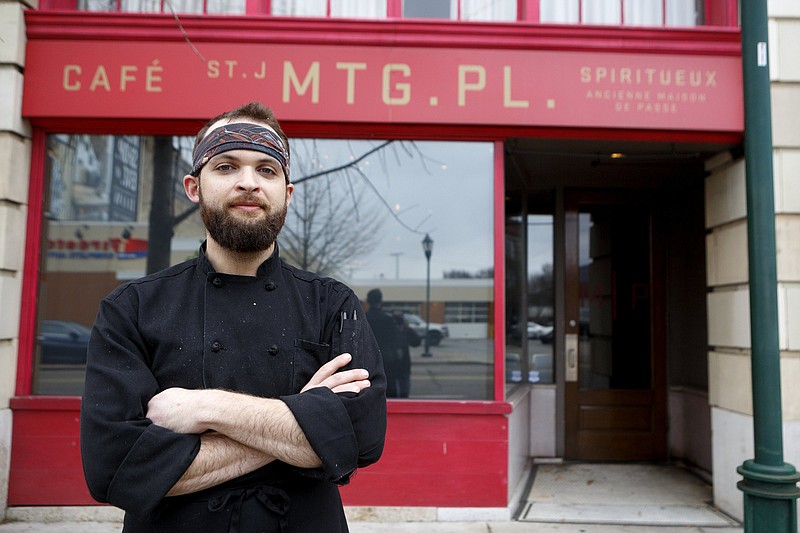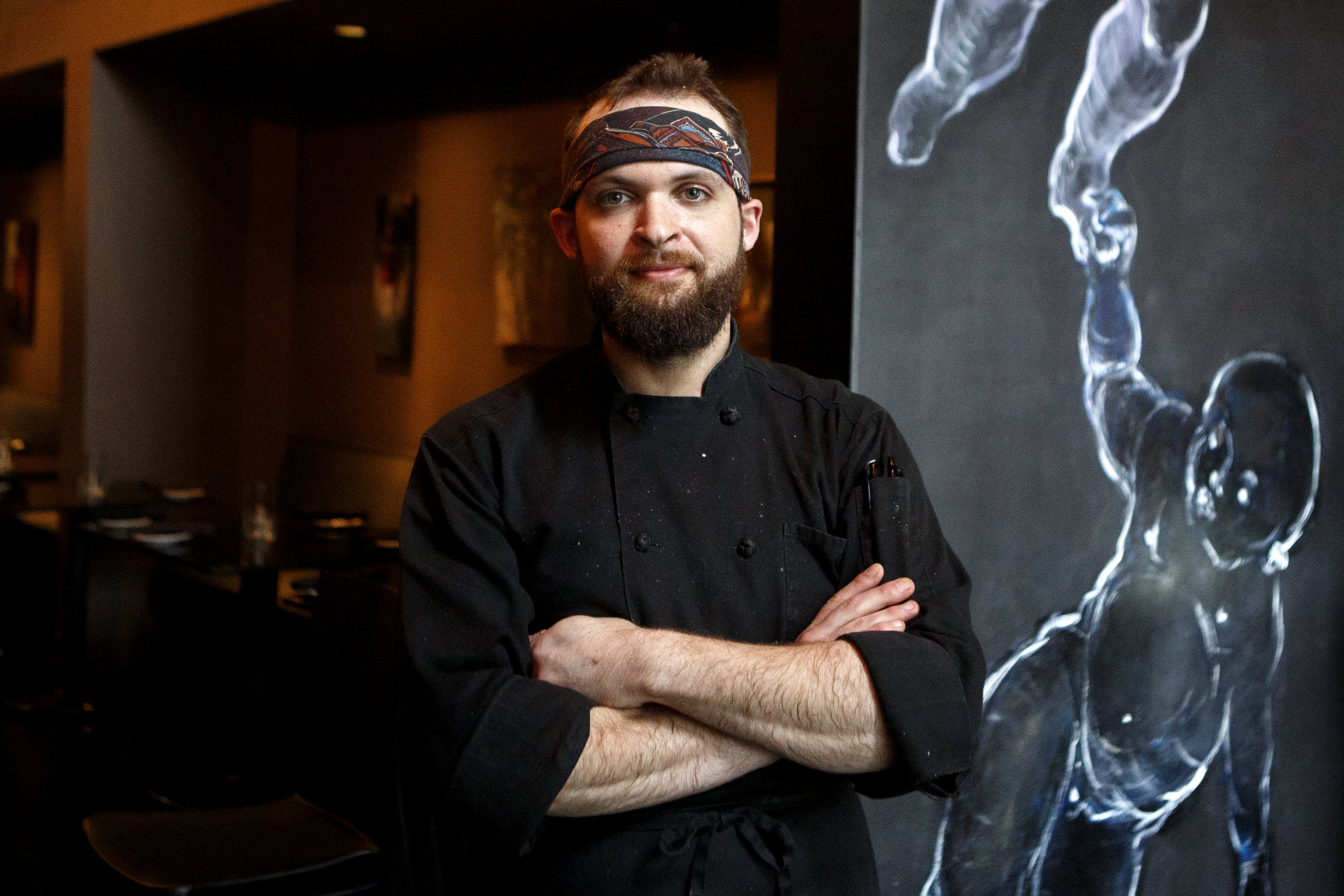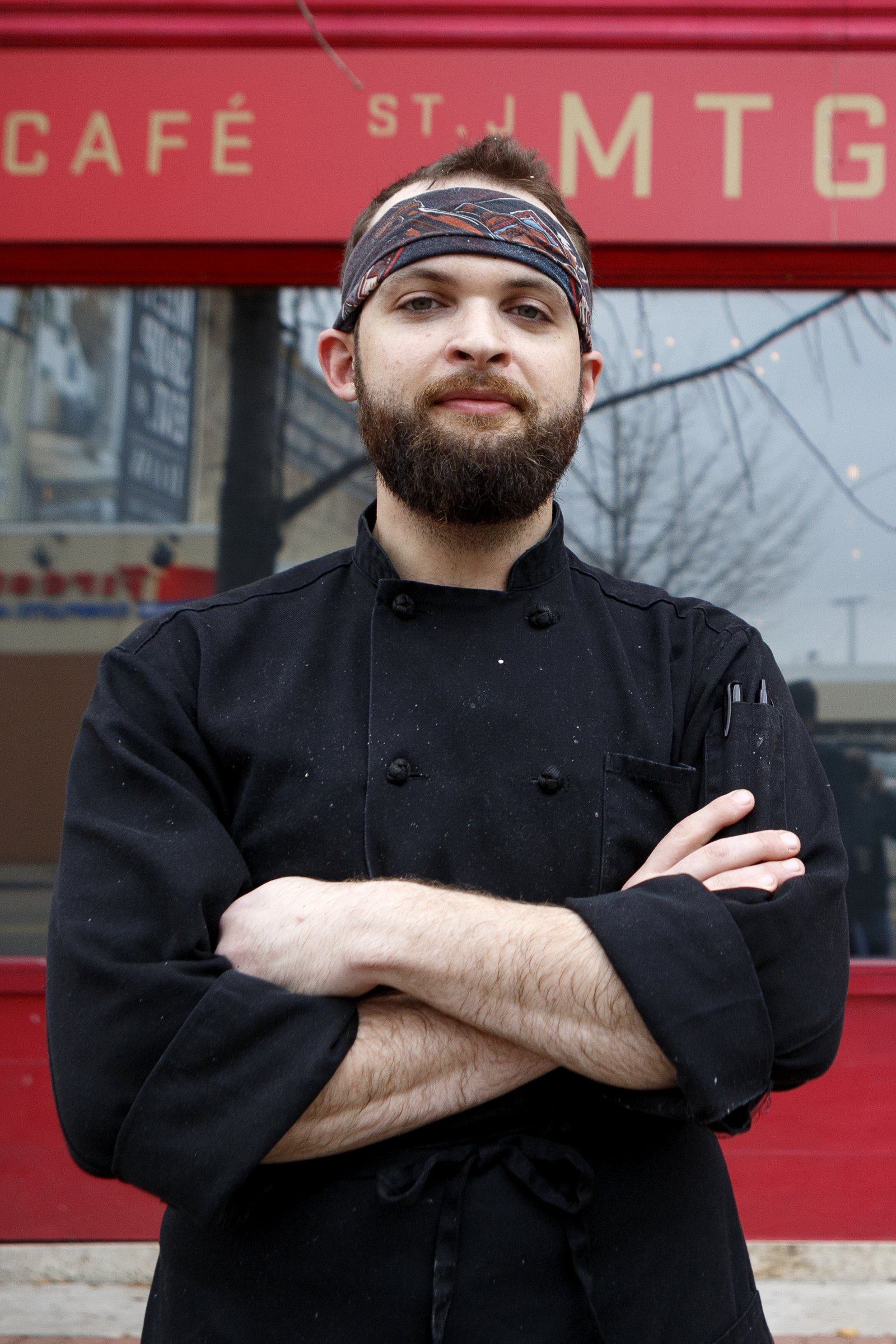"It's like being the conductor of a symphony, but instead of violins and trumpets, you're directing beef and pork." - Micah Adams
A sous chef is best defined as second in command in the kitchen. But ask Micah Adams, now starting his sixth month as sous chef in a six-year tenure at St. John's Restaurant and its sister restaurant, The Meeting Place, and you'll find he describes it in construction terms, which makes sense. In a restaurant's busy kitchen, meals are constructed from an empty plate on up to a beautiful presentation, just like any building.
"As a sous chef, I ensure that everything and everyone is in the position that they're supposed to be," he says. "If the executive chef is the designer, or the architect, then I'm the construction foreman who's making sure that their vision and design is being implemented as best as possible."
A native of Charlottesville, Virginia, Adams says his first trip to Chattanooga was supposed to be nothing more than a quick stop. That was nine years ago. The city, he says, was a good fit - much better than he had anticipated.
Though not classically trained, Adams grew up in a family that enjoyed cooking. "I still make some of my mother's recipes for myself," he says.
Here he reveals his TV sitcom secrets, his guilty food pleasure and the childhood thrill of homemade butter.
Q: What's your earliest food memory?
A: Making fresh butter with my mom. You just put cream in a jar and shake the daylights out of it. It was a really cool moment because it demystified something and made it understandable. Butter wasn't something that just existed. It could be made, and I learned how to make it.
Q: Who inspired you to become a chef?
A: Jacques Pepin, for placing an emphasis on the value of technique. Alton Brown, for explaining the science behind those techniques. Finally, Thomas Keller, for his example of what incredible value you can create by respecting all of the fine details.
Q: Do you have a desire to become an executive chef one day?
A: Absolutely. I'd want to have the opportunity to build a concept from the ground up or make an existing one into the best possible version of itself.
Q: Is working as a sous chef a good stepping stone if you want to open a restaurant?
A: Yes, no question. As a guest, your perception is just the end product. The back-of-house team goes through many, many steps to deliver that product, and the sous chefs are usually the ones orchestrating it all.
Q: What's your favorite job in the kitchen at St. John's?
A: Definitely the grill station. It's where all of the steaks are prepared. It's my favorite because of how technical it is, and sometimes you have to be worrying about as many as 60 individual pieces of meat that all have different characteristics and specified criteria. You have to balance all of the mediums, medium-rares, well-dones and so on, making sure that everything has the right seasoning, and at the same time, plan for each steak to have enough time to rest. It's like being the conductor of a symphony, but instead of violins and trumpets, you're directing beef and pork.
Q: Do you ever get to create your own dishes for the menu?
A: All the time. I have a few dishes at St. John's that have my influence in them, but most of my work is at our sister restaurant, St. John's Meeting Place. My particular favorite is the pot stickers with black garlic ponzu sauce.
Q: How many sous chefs are there at St. John's?
A: There are three. Patrick Sawyer, who manages our butchery, inventory, ordering and organization. Kevin McCue and I are responsible for managing nightly dinner service.
Q: Is there such as thing as "too many cooks in the kitchen?" How's the camaraderie?
A: In the metaphorical sense, there's no such thing. I appreciate hearing many different perspectives on food and cooking, although the science behind it all is universal, I never know when I'll learn something new from someone. In the literal sense, well, it's a tight space, with lots of things to cut and burn stuff. But the staff always gets along great. You have to when you spend as much time together as we do.
Q: What are your hobbies in your free time?
A: I read - my favorite topic and genre is everything, and I'm learning to write code - very slowly. I build computers sometimes.
Q: What's one thing people may not know about you?
A: I've never seen a single episode of "Fraser," "The Office" or "Friends."
Q: What's your guilty food pleasure?
A: Cottage cheese with ketchup. I've never met anyone who didn't think it was nasty.
Q: How do the menus at The Meeting Place and St. John's differ?
A: St. John's is the superlative new-American fine dining experience, with a bent for Southern dishes and ingredients. There's a huge emphasis on quality of ingredients and technique, and although a dish may look straightforward, underneath the hood there are many hours of careful work.
I like to describe the menu at The Meeting Place as one where all the points of French bistro and a Southern meat-and-three come together. It's casual and intimate, the service is very low-key, and you may wind up ordering anything from meatloaf, fried rice or a wagyu steak. It's good food for the sake of good food without pretense.
Q: What do The Meeting Place and St. John's add to the vibe going on in the Southside/Main Street neighborhood?
A: I think it's a cultural anchor. M.L. King Boulevard and Main and Market streets have seen a huge amount of change and development in the past decade, and especially the past five years. The St. John's building has been present as an institution for the entire time and much longer. It's an example of how a city can grow up around a historic building.
Q: What's the one cooking tool you couldn't cook without?
A: My vegetable peeler.
Q: What's your favorite cookbook or food website? Why?
A: "On Food and Cooking" by Harold McGee. Everyone who cooks should own this book. It explains all of the science and chemistry behind things we take for granted. Understanding all of the fine mechanics allows me to explore alternative methods for traditional procedures, which often results in the development of a new method that is just as good as the original, but faster, or cleaner, or more precise.
Q: What's one of your favorite recipes from The Meeting Place?
A: Our chicken liver mousse. It uses and elevates a "yucky" part of the bird. I think if you consume meat, you should be willing to eat the gross parts. It takes a lot to grow that chicken, so don't waste it.
Secondly, this is not my original recipe. I'm not even sure who it's from, it was served at The Meeting Place eight or nine years ago, and I've adopted it to be the best version of itself. Chicken liver mousse is a very classic dish with a lot of history, so it's fun to add my own touch to it.
The Meeting Place Chicken Liver Mousse
To make this recipe, you'll need a food processor or blender; a fine mesh strainer, or cheesecloth if you want to be really traditional; and two frying pans, aluminum or cast-iron.
Canola oil
1 pound chicken livers
1/2 of a white onion, roughly chopped
3 cloves of garlic
2 teaspoons of fresh thyme, chopped
3 tablespoons of brandy (cheap is fine)
4 slices of good-quality bacon
1 stick of unsalted butter
1/2 cup of heavy cream
Salt and black pepper, as needed
In one frying pan, add enough canola oil to cover the bottom, and heat it until the oil just shimmers when you swirl the pan. You can also test the temperature by flicking a drop of water into it - if it pops and sizzles, it's ready. If the oil is smoking, let it cool down a bit.
Thoroughly rinse and dry chicken livers. This part is critical. If there is excess moisture on them, they will not sear, and the difference between a finished recipe with nicely browned livers and pale, gray, steamed ones is immense. Add the livers to the pan, and cook until they're browned on the outside, about 2 minutes on each side. When they're done, they should still be a little pink on the inside, which is perfectly safe. Remove the livers from the pan, and set aside.
Add the onions, garlic and thyme; cook, stirring occasionally, until onions are translucent and lightly browned. Be careful not to burn, as this will be very bitter. Once the onions and garlic are done, add the brandy, and keep cooking until almost all of the liquid is evaporated.
Meanwhile, in the second pan, cook the bacon until crispy, then drain and reserve fat from bacon. Set both aside.
Let everything cool to room temperature, then put the chicken livers, the onion-garlic mixture, the butter and the cream into the food processor, and blend until smooth. Season with salt and pepper, to taste, and strain through a fine-mesh strainer. Scoop all of the mousse into your container of choice, and pour the rendered bacon fat on top. This will help to keep the texture and prevent the mousse from oxidizing.
Allow to chill in the refrigerator at least 2 hours, then top with the crispy, crumbled bacon and serve with your choice of accoutrements, such as toast, crackers or pickles.
Email Anne Braly at abraly@timesfreepress.com.


